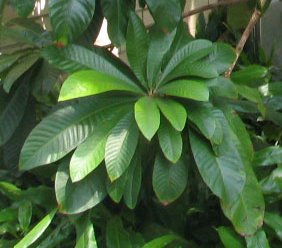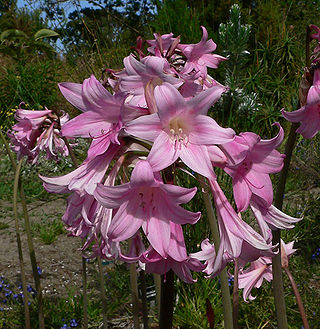
The Mimosoideae are a traditional subfamily of trees, herbs, lianas, and shrubs in the pea family (Fabaceae) that mostly grow in tropical and subtropical climates. They are typically characterized by having radially symmetric flowers, with petals that are twice divided (valvate) in bud and with numerous showy, prominent stamens.

Cypripedioideae is a subfamily of orchids commonly known as lady's slipper orchids, lady slipper orchids or slipper orchids. Cypripedioideae includes the genera Cypripedium, Mexipedium, Paphiopedilum, Phragmipedium and Selenipedium. They are characterised by the slipper-shaped pouches of the flowers – the pouch traps insects so they are forced to climb up past the staminode, behind which they collect or deposit pollinia, thus fertilizing the flower. There are approximately 165 species in the subfamily.

Hamamelidaceae, commonly referred to as the witch-hazel family, is a family of flowering plants in the order Saxifragales. The clade consists of shrubs and small trees positioned within the woody clade of the core Saxifragales. An earlier system, the Cronquist system, recognized Hamamelidaceae in the Hamamelidales order.

The Sapotaceae are a family of flowering plants belonging to the order Ericales. The family includes about 800 species of evergreen trees and shrubs in around 65 genera. Their distribution is pantropical.

Niemeyera is a genus of plants in the family Sapotaceae described as a genus in 1870. The entire genus is endemic to Australia. Its closest relative is Pycnandra from New Caledonia.
- Niemeyera chartacea(F.M.Bailey) C.T.White - Queensland
- Niemeyera prunifera(F.Muell.) F.Muell. - Queensland
- Niemeyera whitei(Aubrév.) Jessup - Queensland, New South Wales

Pleioluma is a genus of flowering plants in the family Sapotaceae. It includes 40 species of evergreen hermaphroditic or gynodioecious trees, reaching up to 25 meters tall.

Chrysophylloideae is a subfamily of flowering plants in the chicle family, Sapotaceae.

Cercidoideae is a subfamily in the pea family, Fabaceae. Well-known members include Cercis (redbuds), including species widely cultivated as ornamental trees in the United States and Europe, Bauhinia, widely cultivated as an ornamental tree in tropical Asia, and Tylosema, a semi-woody genus of Africa. The subfamily occupies a basal position within the Fabaceae and is supported as monophyletic in many molecular phylogenies. At the 6th International Legume Conference, the Legume Phylogeny Working Group proposed elevating the tribe Cercidae to the level of subfamily within the Leguminosae (Fabaceae). The consensus agreed to the change, which was fully implemented in 2017. It has the following clade-based definition:
The most inclusive crown clade containing Cercis canadensisL. and Bauhinia divaricataL. but not Poeppigia proceraC.Presl, Duparquetia orchidaceaBaill., or Bobgunnia fistuloides(Harms) J.H.Kirkbr. & Wiersema.

Planchonella is a genus of flowering trees in the gutta-percha family, Sapotaceae. Named in honour of Jules Émile Planchon, it was described by Jean Baptiste Louis Pierre. It contains around 110 mainly tropical species, which range from Pakistan through Southeast Asia and New Guinea to northern and eastern Australia, New Zealand, and the Pacific Islands. The genus is included in the larger genus Pouteria by some authorities, hence species such as Planchonella australis are also known as Pouteria australis.

The Amaryllidaceae are a family of herbaceous, mainly perennial and bulbous flowering plants in the monocot order Asparagales. The family takes its name from the genus Amaryllis and is commonly known as the amaryllis family. The leaves are usually linear, and the flowers are usually bisexual and symmetrical, arranged in umbels on the stem. The petals and sepals are undifferentiated as tepals, which may be fused at the base into a floral tube. Some also display a corona. Allyl sulfide compounds produce the characteristic odour of the onion subfamily (Allioideae).
Pichonia is a group of trees in the Sapotaceae described as a genus in 1890.

Sersalisia is a genus of trees in the family Sapotaceae described as a genus in 1810.
Planchonella rufocostata is a species of plant in the family Sapotaceae. It is endemic to New Caledonia. As with other species in the same genus, it possesses stamens that are located below the tube orifice; a multi-seeded fruit, as well as foliaceous cotyledons embedded in endosperm.
Planchonella roseoloba is a species of plant in the family Sapotaceae. It is endemic to New Caledonia. As with other species in the same genus, it possesses stamens that are located below the tube orifice; a multi-seeded fruit, as well as foliaceous cotyledons embedded in endosperm.
Planchonella luteocostata is a species of plant in the family Sapotaceae. It is endemic to New Caledonia. As with other plants in the same genus, it possesses stamens that are located below the tube orifice; a multi-seeded fruit, as well as foliaceous cotyledons embedded in endosperm.
Planchonella glauca is a species of plant in the family Sapotaceae. It is endemic to New Caledonia. As with other species in the same genus it possesses stamens that are located below the tube orifice; a multi-seeded fruit, as well as foliaceous cotyledons embedded in endosperm.
Planchonella crenata is a species of plant in the family Sapotaceae. It is endemic to New Caledonia. As with other species in the same genus, it possesses stamens that are located below the tube orifice; a multi-seeded fruit, as well as foliaceous cotyledons embedded in endosperm.

Pycnandra acuminata is a species of plant in the family of Sapotaceae. It is a rainforest shrub, endemic to New Caledonia, and is adapted to the nickel-rich ultramafic soils found there. Pycnandra acuminata is notable as one of the most prolific hyperaccumulators of trace metals known, actively absorbing nickel from the soil and concentrating it within the plant to a concentration of up to 25% nickel citrate as dry weight of the sap, which is turquoise-green in colour due to the nickel content. the only known plant with turquoise sap. An excellent photo can be seen at. The vernacular name in French is sève bleue.

Sempervivoideae is the largest of three subfamilies in the Saxifragales family Crassulaceae, with about 20–30 genera with succulent leaves. Unlike the two smaller subfamilies, it is distributed in temperate climates. The largest genus in this subfamily is Sedum, with about 470 species.

Agatea is a genus of flowering plants in the violet family Violaceae, with seven accepted species, found in New Guinea and New Caledonia.














